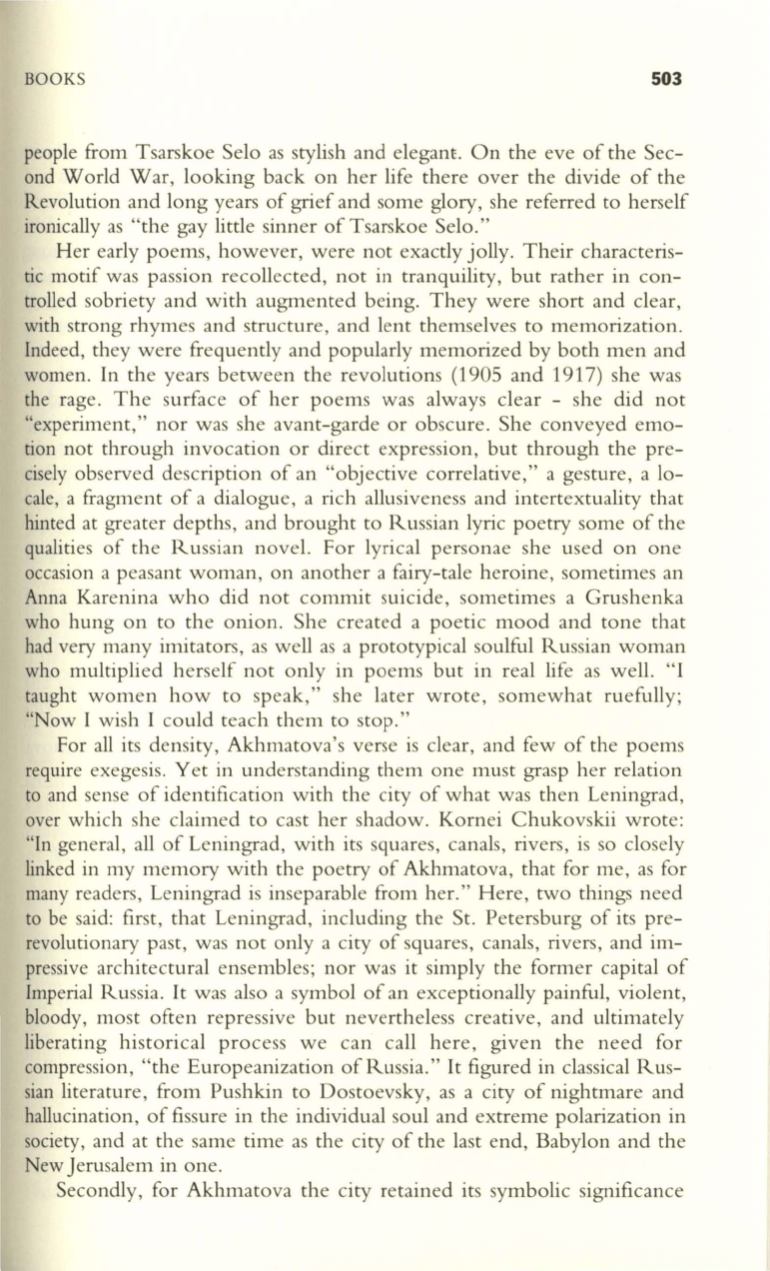
BOOKS
503
people from Tsarskoe Selo as stylish and elegam. On the eve of the Sec–
ond World War, looking back on her life there over the divide of the
Revolution and long years of grief and some glory, she referred to herself
ironically as "the gay little sinner of Tsarskoe Selo."
Her early poems, however, were not exactly jolly. Their characteris–
tic motif was passion recollected, not in tranquility, but rather in con–
trolled sobriety and with augmented being. They were short and clear,
with strong rhymes and structure, and lent themselves to memorization.
Indeed, they were frequently and popularly memorized by both men and
women. In the years between the revolutions (1905 and 1917) she was
the rage. The surface of her poems was always clear - she did not
"experiment," nor was she avant-garde or obscure. She conveyed emo–
tion not through invocation or direct expression, but through the pre–
cisely observed description of an "objective correlative," a gesture, a lo–
cale, a fragment of a dialogue, a rich allusiveness and intertextuality that
hinted at greater depths, and brought
to
Russian lyric poetry some of the
qualities of the Russian novel. For lyrical personae she used on one
occasion a peasant woman, on another a fairy-tale heroine, sometimes an
Anna Karenina who did not commit suicide, sometimes a Grushenka
who hung on to the onion . She created a poetic mood and tone that
had very many imitators, as well as a prototypical soulful Russian woman
who multiplied herself not only in poems but in real life as well. "I
taught women how to speak," she later wrote, somewhat ruefully;
"Now [ wish I could teach them to stop."
For all its density, Akhmatova's verse is clear, and few of the poems
require exegesis. Yet in understanding them one must grasp her relation
to and sense of identification with the city of what was then Leningrad,
over which she claimed to cast her shadow. Kornei Chukovskii wrote:
"In general, all of Leningrad, with its squares, canals, rivers, is so closely
linked in my memory with the poetry of Akhmatova, that for me, as for
many readers, Leningrad is inseparable from her." Here, two things need
to be said: first, that Leningrad, including the St. Petersburg of its pre–
revolutionary past, was not only a city of squares, canals, rivers, and im–
pressive architectural ensembles; nor was it simply the former capital of
Imperial Russia. It was also a symbol of an exceptionally painful, violent,
bloody, most often repressive but nevertheless creative, and ultimately
liberating historical process we can call here, given the need for
compression, "the Europeanization of Russia." It figured in classical Rus–
sian literature, from Pushkin to Dostoevsky, as a city of nightmare and
hallucination, of fissure in the individual soul and extreme polarization in
society, and at the same time as the city of the last end, Babylon and the
New Jerusalem in one.
Secondly, for Akhmatova the city retained its symbolic significance


